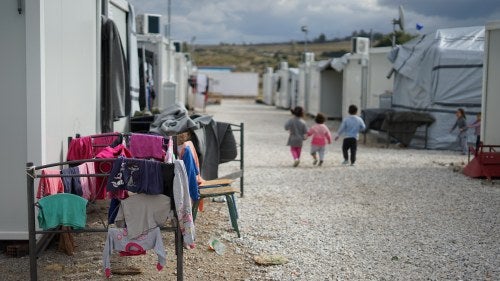Sanctuary Cities are Critical to Managing the Global Refugee Crisis

Cities are the primary reception point for migrants and refugees, and also the potential antidote to the reactionary nationalism that threatens to close borders.
The world is facing unprecedented and catastrophic levels of population displacement. At least 65 million people are on the move, including 21 million refugees and 41 million internally displaced persons. That means that 1 in every 100 people globally is displaced from their home.
There is not just one global refugee crisis, but rather multiple overlapping crises. To be sure, North Africa, the Middle East, and South and Southeast Asia are especially badly affected. A new data visualization called "Earth Timelapse" captures the scale and distribution of crises between 2001-2016. Each dot on the screen represents stories of struggle and survival.
It reveals a number of important insights.
First, contrary to what many people in North American and Western European countries and cities assume, they are not the primary destination of refugees. The United States, for example, has accepted roughly 0.25% of the total population of concern since the early 1990s.
Second, people are not moving from poor countries into rich countries. Instead, they are moving from poor countries into poor countries. The vast majority of people fleeing armed conflict and terrorism in Iraq, Syria, and Yemen are installing themselves in neighboring countries.
Third, there is a robust relationship between terrorism and migration flows. But it is not in the direction described in the media. Refugees are not committing terrorist acts: they are fleeing from them. In the United States, of the roughly 785,000 refugees admitted to the U.S. since 9/11, none has committed a fatal terrorist act. Less than a dozen were arrested or removed owing to terrorism concerns.
Cities are the primary reception point for new arrivals, including refugees. They are also a potential antidote to reactionary nationalism around the world that threatens to close borders, divide communities, and reject migrants, including those fleeing political violence. Cities are instinctively open, diverse and cosmopolitan.
“Sanctuary cities” in the United States are more important than ever to ensure the protection, care and resettlement of new arrivals. But the 40 or so sanctuary cities in the United States are coming under attack. In the US, the Trump administration has signed an executive order to block federal funding to cities and counties that protect illegal immigrants by not prosecuting them for violating federal immigration laws in the city where they live.
Meanwhile, “cities of sanctuary” in the UK offer another approach to improving durable and compassionate solutions for refugees. Initiated in 1999, the 80 cities of sanctuary in the UK are committed to welcoming refugees, asylum seekers and others seeking safety. They are actively building bridges by raising public awareness, creating linkages with sister cities, and fostering partnerships through the arts.
Clearly the best way to end the refugee crises is to end conflicts generating population flight. This will require more engagement, not less. Cities will also need to step up to meet this challenge. They will find strength in numbers, acting collectively rather than in isolation. Inter-city networks such as the Global Parliament of Mayors and the United Cities and Local Governments will be more important than ever to deliver the support that refugees so urgently deserve.

